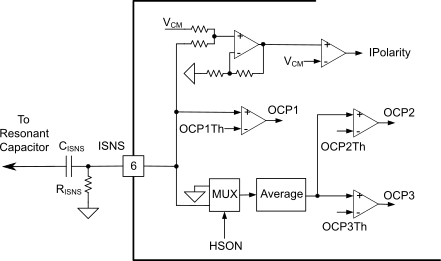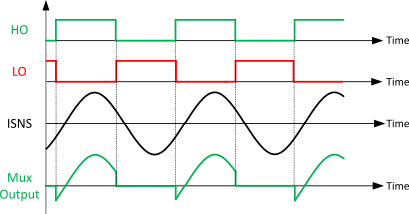SLUAAJ7 June 2022 UCC256402 , UCC256403 , UCC256404
- Abstract
- Trademarks
- 1UCC25640x Selection Guide
- 2UCC25640x Features Brief Overview
- 3UCC25640x Power Up Guidelines and Debugging Notes
- 4References
2.8.1 OCP Protection
 Figure 2-33 Over
Current Protection (OCP) Protection
Figure 2-33 Over
Current Protection (OCP) Protection Figure 2-34 High
Side Switch Current Extraction from ISNS Signal
Figure 2-34 High
Side Switch Current Extraction from ISNS Signal - Resonant current is reconstructed as ISNS voltage using a differentiator connected to the resonant capacitor.
- OCP1 (OCP1Th: 4 V) is for output short circuit protection; it checks the magnitude of the resonant current.
- OCP2 (OCP2Th: 0.6 V) is for over-load protection; it checks the average DC input current. The time the average input current needs to stay above OCP2 threshold before OCP2 is triggered is 2 ms.
- OCP3 (OCP3Th: 0.43 V) is also for over-load protection but it has lower threshold value compared to OCP2, OCP1; it checks the average DC input current. The time the average input current needs to stay above OCP3 threshold before OCP3 is triggered is 50 ms.
- DC input current is reconstructed by capturing the current flowing through high side MOSFET.
- Internally, ISNS voltage is truncated when HO is high and then filtered to get the average dc value.